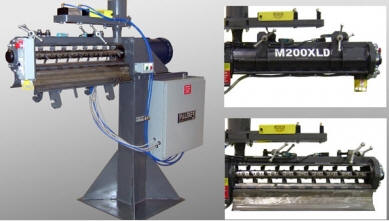Foundry & industrial processing Machinery EQUIPMENT & SYSTEMS
U.S. & Canada Call 1.800.457.5456
Basic Principles of Sand Mixing
Home Articles Basic Principles of Sand Mixing

Foundry Management & Technology Magazine, January 14, 2014 issue.
Written - Jack Palmer.
Reprinted by permission of Penton Media, Inc.
Even with advanced timers, flowmeters, and valving, the objective is to make the initial sand usable, and exactly the same as the sand that follows it.

A close-tolerance gear pump coupled with a properly designed drive system will result in consistent, repeatable delivery of sand. There are fit tolerances for any gear-style pump that must be maintained in order to allow the parts to move against each other.
Mixing of any material or combination of materials is accomplished by moving the materials together against themselves. The mixer, regardless of design or materials to be blended, exists only to accomplish a uniform distribution of the components. Whether mixing concrete, polymers, liquids, powders, or silica sand with differing chemical system, the purpose of the mixing machine is to move the materials against themselves.
In our industry we are mixing sands with very small amounts of different binding agents, all having different and variable properties. The first sand that exits the chamber is obviously not the same as the sand a few seconds behind it, as there is really nothing for the first sand to move against. Even with today’s technologies (timers, flowmeters, valving), we cannot get away from this basic goal: to make the first sand usable, and exactly the same as the sand right that follows it.
It is a simple process to catch the first 1-2 seconds of sand that exits the mixer and then put it in the molds as soon as the pattern is covered. A properly trained and motivated mixer operator will waste very little sand.
The object of a continuous mixer is to produce sand for quality cores or molds using just enough binder to obtain the desired casting results at the lowest possible cost. Chemicals are a high percentage of the casting cost. Lower resin levels reduce costs, improve the reclamation process, and improve the working environment. In order to keep chemicals levels as low as possible it is important to control the temperature variables.
The preferred temperature for sand and resin is in the 85-95°F range. The set time of PUNB is either doubled or halved for every 18°F change in sand temperature. Unless sand temperature is well controlled, production rates will suffer. Even if the strip time is reduced with additional catalyst (expensive) the evaporation of solvents remains retarded due to the low sand temperature resulting in a higher potential for gas defects.
Heating sand with a traditional fluidized resistance element design can be costly because compressed air is cool and therefore uses a lot of power to raise the sand temperature 20-30° at the flow rates required.
This high kW requirement can add to the monthly electric bill if it is a demand-based system. Fluidized bed heaters with hot water require substantially less energy and are more accurate because the residence time in the comparatively larger chambers is longer, but capital costs are usually double the cost of resistance element designs. While the end temperature is important, the consistency and repeatability of temperature is equally important. The capital and operating costs of correctly sized sand heaters are high, but usually can be justified by lowered resin requirements, greater production levels, fewer scrap molds/cores, and more consistent production.
Resin temperatures should be as close as possible to the correctly heated sand. The normal response to cold resins is to install a drum heater or heat lamps. While these are helpful, they can be problematic; if left on too long or at too high a temperature, the characteristics of the resin can be dramatically changed.
As the solvent evaporates or resin advances, the performance, viscosity, and metering characteristics will change.
These vessel heating techniques usually only heat a couple inches into the drum or tote. The majority of the liquid’s temperature is unchanged – and this difference in temperature within a single drum is another variable that needs to be eliminated.
The correct technique is to have a dedicated recirculation pump that takes the chemical from the bottom of the container, runs it through an in-line heating device, and returns it to the top of the container. This system keeps the chemical throughout the container at the same temperature at all times. Additions to this container should never be more than 25% of the container size to allow the heating system to recover as quickly as possible while still in production.
Mixer Design Details
A properly designed high-speed continuous sand mixer requires a number of criteria to be met. While a mixer is a very simple mechanism in itself, a great deal of technology is required for optimal results.
Mixing efficiency depends on retention time, blade tip speed, thickness of the sand on the inside of the chamber, and horsepower.
1. Retention time - If the mixture is in the chamber for too short of a time, there is the potential for weak molds/cores, streaking, resin balls, etc. If the residence time is too long, there is the possibility of excessive heating of the sand that causes a breakdown of the sand, and change in properties of the binder. Each application differs relative to sand type, shape, and screen analysis and there are a number of resin systems with different viscosities, addition rates, and ratios. Proper testing of a particular application is required to optimize the retention time.
2. Blade tip speed - Retention time is controlled by blade configuration and rpm/blade tip speed. Careful testing along with proven historical results determines this design. Some systems perform better with a low-speed/long retention time while for others, the opposite can be true.
Varied combinations of three different blade angles — 45° forward, 0°, and 45° reverse — can properly blend virtually any sand. Variable-pitch threaded blades should be avoided as they loosen, take much longer to install, and provide an opportunity for over adjustment. Higher retention times can result in a post flow of small amounts of sand.
3. Thickness of the sand on the inside of the chamber - Centrifugal mixing is usually achieved at about 300-350 rpm. At this speed, the sand/resin mixture is being actively rubbed against itself in a peripheral layer along the wall of the mixing chamber.
There are minimum and maximum amounts of sand that can be efficiently mixed with a given mixer size: Too little, and there isn’t enough mass to blend together; too much, and the sand on the inner portion of the sand wall is not rubbing together with the same velocity.
4. Horsepower - Sufficient horsepower must be available to keep the shaft speed consistent. While standard motor rpms 890, 1,150, and 1,750 can be used in many cases, variable-frequency drives (VFD) can be used to achieve the optimal speed for a given combination of throughput, resin system, and sand (size, shape, screen analysis.) Usually gearboxes and pully/belt designs should be avoided, as they are an unnecessary and uneconomical mechanical complication.
Metering of Materials
Accuracy and repeatability of material addition is critical. The free flow of sand itself is critical to ensure a consistent sand flow for the no-bake process. Water is the kiss of death – as little as 0.2% moisture on the sand will alter the sand flow rates significantly. Chemical performance also will be inhibited. Some resin systems are affected more drastically than others.
Sand by nature does not lend itself to precision metering in comparison to the levels achievable with liquids. A fixed-orifice metering system for sand is optimal. If a slide gate is used, it should be a hole, not a plate that hits an adjustable stop. The fixed orifice allows for a smooth and repeatable flow of sand into the chamber. Articulated mixers with a “dam gate” metering design should have a rigid support under the belt to keep the relationship between the bottom of the dam and the top of the belt as consistent as possible.
The fine powders that are sometimes required for metallurgical or surface finish need uniform dispersion. These powders are usually very difficult to meter as they have a tendency to ‘rathole’ and pack. There are some that will actually achieve a negative angle of repose.
The best current technology for metering small precise amounts of these powders is a flexible hopper wall, centerless helix design. The urethane hopper is externally “massaged” which keeps the powder active and of a consistent density around the centerless helix. The centerless helix is used in place of a traditional auger or screw since it will not “pack up” with material. By maintaining a consistent density of material, and very precisely controlling the rpm of the helix, very accurate amounts of difficult powders can be metered. It is critical that the helix turns at least 45 rpm and no faster than 200 rpm.
Any screw type handling device discharges in a pulsing-type flow because every flight pushes a given amount out of the housing. By turning at least 45 rpm this pulse is minimized. Lower speeds will produce the right amount of powder per minute; the correct amount per second is necessary. This is critical because the retention time of sand in a modern high-speed mixer is usually only 2-5 seconds. Helix speeds above 200 rpm do not provide enough time for the material to react between the flights, resulting in inaccurate and non-repeatable flows. The helix speed is kept in the correct range by selecting the correct diameter of the helix.
Determining Equipment Matches
There is a multitude of liquid metering equipment with variable compatibility, which influences the accuracy, repeatability, and durability of resin metering systems. The three main criteria determining the equipment required for a given application are: output volume, material compatibility, and viscosity.
While it is important to maintain an accurate resin flow, an accuracy of less than ±1% of total flow isn’t always necessary. Maintaining a flow within this range is usually more important than maintaining a resin flow rate of ±0.01%. While these accuracies of 0.01% are certainly achievable with today's Coriolis-flow meters, they are not always economical, given the high cost of the flow meters and computer controls.
A close-tolerance gear pump coupled with a properly designed drive system will result in consistent, repeatable delivery. There is no such thing as a positive-displacement gear pump. There are fit tolerances in any gear-style pump that must be maintained in order to allow the parts to move against each other. This is normally called slip, which is the amount of liquid that can bypass or slip past the gears. It is usually minimal, but it is a consideration as lower-cost pumps traditionally have more slip because it is less costly to manufacture to looser tolerances. Pump slip, which as a function of speed is increased at lower speeds, must be considered in the pump sizing design phase.
A pump turning at too high of a speed can result in cavitation and premature wear. Pump construction, size, and speed of rotation are very different depending on the liquid, flow rate, and viscosity.
Equally important in the pumping system is the drive. Maintaining an exact RPM is important, but maintaining the correct rotating speed per second is even more critical. If a system is designed with the wrong pump or drive for a given resin system, there is a very real possibility of a one-minute calibration test showing a repeatable flow but still having significant flow variation per second. While DC motors and speed controls are proven performers and have accurate and repeatable speed in a large speed range, AC VFDs are preferred in some systems, equipped with flow meters and PLC controls due to simplicity of configuration.
There are only two types of resin flow controls, contact and non-contact. The non-contact systems are the most common and are essentially speed controllers. A system that is considered a contact type has some type of wetted flow meter. These flow meters (many different types) can be a non-moving vibratory type as in a Coriolis-type flowmeter, or a dual gear-based design where the flow rotates the gears and a sensor of some type counts the rotations, and a PLC converts the counts to a flow.
It is critical with any system to physically measure chemical flows at the mixing chamber. Many times we see people relying on HMI RPM readout, or checking flow using a three-way valve right after the pump to ensure correct flow. While these may be correct at most times, measuring at the mixing chamber is always correct. The fitting that goes into the chamber should be removed; even if the hose going to the fitting is removed, there is a very real possibility of the fitting being restricted in some way, even if a system is equipped with purge air. A physical measurement should be done regularly to verify the accuracy of the flow even with installed meters occasionally.
Timers and Cycles
The flow control system should always be equipped with a calibration timer to ensure the calibration cycle (commonly 30 seconds) is always the same. There is a large percentage variation between 28 and 32 seconds that is common when calibrating by hand with a watch.
A high-quality scale that is regularly calibrated is an important part of control. It needs to be durable enough to stand up to the foundry environment and accurate enough to ensure measurement within the acceptable tolerance of the process.
For such a simple mixing machine, there can be a myriad of potential problems. Usually these problems are associated with improper maintenance or cleaning. Performing regular maintenance, calibration, and cleaning are critical to the production of quality molds and cores. It is much better to catch problems in the molding area or core room. The alternative is to discover mold/core related defects in the cleaning room or, worse, in the machine shop, or worse yet, as rejections from the customer. The amount of time spent maintaining and calibrating the mixer is infinitesimally small compared to the costs of neglecting to do this routinely.
- far, the majority of service calls we receive turn out to be simple plumbing issues. A properly designed pumping system with the supply above the pump (which provides a flooded suction), with the pump as the lowest point in the system and the inlet to the mixer above the pump but below the supply, will produce accurate and repeatable performance. Regular replacement of hoses, fittings, and piping will pay off many times in the long term.
It is not uncommon for hours or even days of production to be lost simply because of an internally collapsing hose, floating obstruction in piping, improperly rerouted hoses and the like.
Probably the most critical item in day-to-day reliability and consistency of production is the cleaning of the mixing chamber. It is only necessary to regularly clean the mixing blades, shaft, and discharge from the chamber. Cleaning should be performed every shift or day. It only takes a few minutes to clean a chamber on a regular basis. Whether by the shift, by the day, or by a certain number of operational hours, cleaning needs to be performed on a regular basis.
It is also important to never clean the inside of the mixing chamber unless replacing blades. There should be minimal clearance between the edge of the blade and the inside of the mixing chamber to ensure all sand is mixed. As a blade wears the lining is regenerated which maintains the minimum distance between the end of the blade and the inside of the mixing chamber.
The high-speed continuous mixer is a critical component in the casting production process, and as such deserves and requires rigorous attention to detail.
Jack Palmer is the president and Ken Strausbaugh is a technical sales and service representative, both with Palmer Manufacturing & Supply Inc. Visit www.palmermfg.com
Copyright © 2025 Palmer Manufacturing & Supply, Inc. | Terms and Conditions | Privacy Policy




